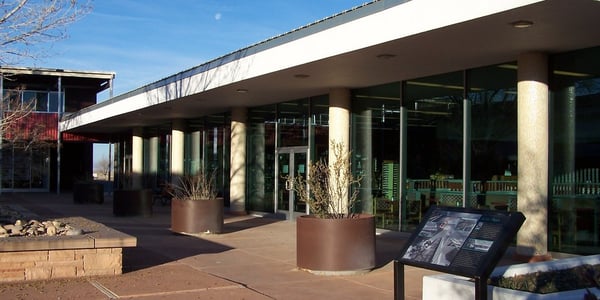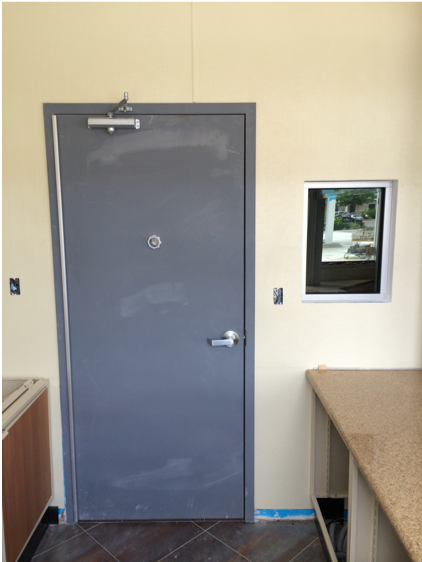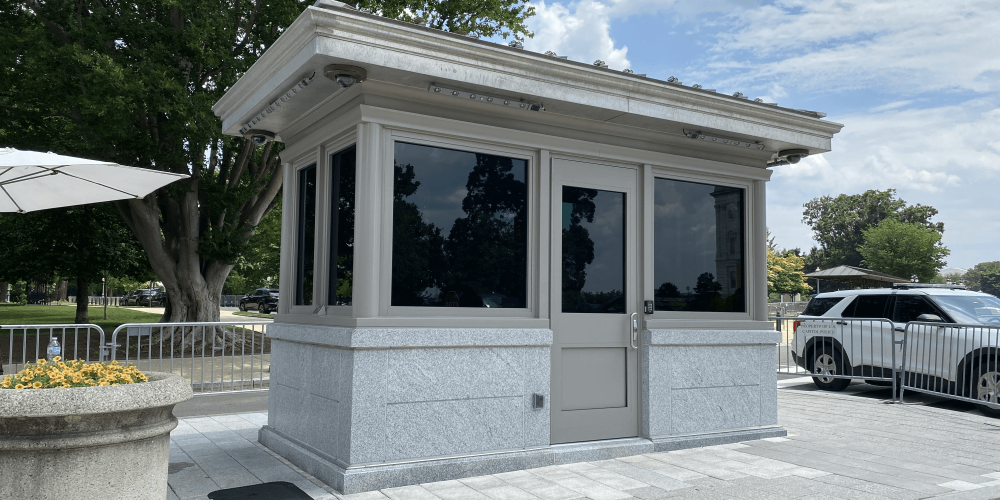There's increasing demand for "storefront" style bullet-resistant barriers in non-retail settings. These are bullet-resistant doors and storefronts that employ the "all-glass" look of modern retail, but incorporate bullet-resistance and other physical security features.
In the example below, the all-glass doors of the Painted Desert Community Complex give the administrative buildings a distinct “storefront” look.

In general, these "all-glass" bullet-resistant doors are built to meet UL-752 Level 3 or Level 5 physical security expectations. A Level 3 door will stop clusters of shots from any handgun. A Level 5 door will do likewise, with the added benefit of stopping a shot from a high-powered rifle and potentially holding up better against attempts at forced entry.
 But what if you require greater security? For example, what do you do for a government guard booth, where a vehicle ramming attack is possible, or an attacker may be armed with a military-style tactical rifle?
But what if you require greater security? For example, what do you do for a government guard booth, where a vehicle ramming attack is possible, or an attacker may be armed with a military-style tactical rifle?
In these cases, you need UL-752 Level 8 bullet-resistant glass and doors. Not only will these stop many rounds from all manner of handguns and long-guns; they also reliably stop bursts from both AR-platform (.223/5.56mm) and other (i.e., 7.62mm) tactical rifles. In most cases, they offer implicit protection from forced entry and blasts (and in some cases are both tested and rated for blast- and forced-entry resistance).
But there's a catch. Level 8 bullet-resistant doors are almost exclusively produced for the military, government facilities, or special applications (like protecting visiting foreign dignitaries). And they look the part:
What if you need a Level 8 door that looks like any other storefront door?
Until recently, you were probably out of luck.
The Challenge: A Regular Storefront with Level 8 Protections
Let's take a minute to understand why Level 8 bullet-resistant doors look so industrial. In part, it's because private and commercial customers rarely need a Level 8 door. As such, there's very little "market pressure" driving demand for an attractive Level 8 door.
But it is also a matter of practicality: a normal commercial steel door with a small window is 1.75-inches thick and weighs 100 to 200 pounds. A similar steel door built to withstand a Level 8 attack generally needs to be thicker to accommodate UL-752 Level 8 bullet-resistant glass—which is itself around two inches thick. Then, the door itself is lined with armor plate, making it substantially heavier—at least 400 pounds. That requires heavier hinges, heavier frames, heavier everything.
Such a bulky door wouldn't look out of place on a battleship or in Fort Knox. But they do look out of place in a government office or the guard booth outside of a national monument.
Nonetheless, that was exactly the challenge TSS was asked to address earlier this year:
Create a UL level 8 door that stops bullets and resists attack just as well as one of these steel vault doors, but looks like any other high-visibility glass storefront or office door.
The Innovation: A Never-Before-Fabricated Safety Solution
A normal commercial glass storefront door is 1-3/4-inches thick with 1/4" to 1" thick glass. You see them at every business you enter.
It's not unusual to make such doors with Level 3 (or even Level 5) ballistic security. Such doors can stop sprays of gunfire from any pistol and, in the case of Level 5, can also deflect several shots from a high-powered rifle. Level 5 ballistic doors are usually 2-3/8-inches thick with glass between 1-1/4 and 1-5/8th-inches thick. Bulkier and heavier than standard doors, but still unlikely to attract notice or pose huge engineering or installation challenges.
Now consider a hypothetical Level 8 ballistic "storefront" style door. The glass itself would be over 2 inches thick, resulting in a door that's four inches thick and weighs over 500 pounds.
And consider the application: TSS was contacted by an agency which was replacing dozens of existing security booths. These had been built over years—some to Level 3 standards and others to Level 5. Meanwhile, the threat landscape had evolved: people targeting government locations were increasingly using high calibers, motor vehicles, or taking advantage of the chaos of protests and civil unrest. They needed booths with Level 8 ballistic security, ones that offered enhanced security against ramming attacks or prolonged attempts to breach the building.
What made this especially tricky was that the replacements would be happening gradually, over the course of a few years. For security reasons, the new doors and windows needed to perfectly match the originals, despite being twice as thick and heavy.
And TSS had eight weeks to deliver those never-before-created UL 752 level 8 bullet-resistant glass doors and windows.
8 Weeks to Level 8 Doors: How TSS Made It Happen When Others Couldn’t
Interestingly, TSS was not the original vendor selected for this project. But when it came time to move from design to fabrication, that original supplier ran into trouble.
In part, this was a matter of sourcing. Supply chain issues have created havoc for builders, making even very common materials—aluminum channel, steel, lumber—inexplicably hard to find or expensive to acquire. That's compounded when it comes to niche products. In this case, in order to make sure the renovated booths matched the existing ones, they needed a distinctive tint of glass-clad polycarbonate bulletproof glazing. Other bulletproof companies were finding that they would need 16 to 18 weeks to source the right glass and 3 to 6 months to get door hardware.
Meanwhile, since early in the pandemic, TSS had invested in building networks of secondary and tertiary suppliers. We were able to reach into this network and track down the necessary supplies on short notice.
TSS was also well situated to take on the engineering and fabrication challenges that come with creating an entirely new product.
"Door hardware is usually made for a 1-3/4-inch standard commercial door," explains a TSS team member who worked directly on this project. "Oftentimes, on our 2-3/8 Level 5 door, you can still make that work, using an extension kit. But there are very few extension kits made for 4-inch doors. This is a common issue: the higher the [security] level, the less functional the components are.” And if one component is less functional, it makes the whole system less functional.
But TSS had team members with engineering experience and a background in door hardware, allowing us to find a way to work around this potential limitation.
TSS Starts with “Yes-Can-Do”
What really made this possible, according to Inside Sales Rep Todd Ross, was the “Yes-Can-Do” attitude that permeates TSS.
“We did a 12 to 16-week project in 6 to 7 weeks, developing a product that previously didn’t exist," Ross marvels. "Everything had to come together to make this work, and it did. … It really demonstrated our three uniques: Customer Service, Customization, and Speed."
For Ross, this project shows how TSS cultivated its reputation for delivering on their promises: "The thing I appreciate about [TSS CEO] Jim [Richards] is that he fosters a can-do, ‘yes’ attitude, based on his long experience in the industry. We know, as a sales team, that TSS can find a solution to problems and create new solutions.”
Do you have a challenging project on the horizon? Contact our ballistic security experts to explore possible solutions.

